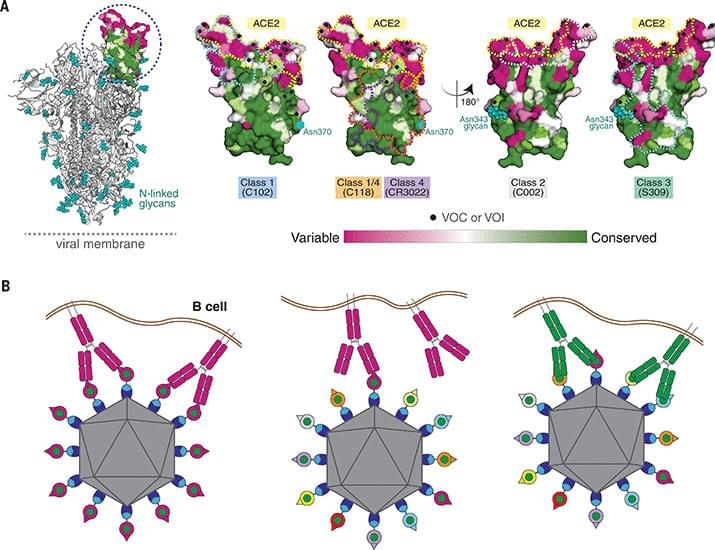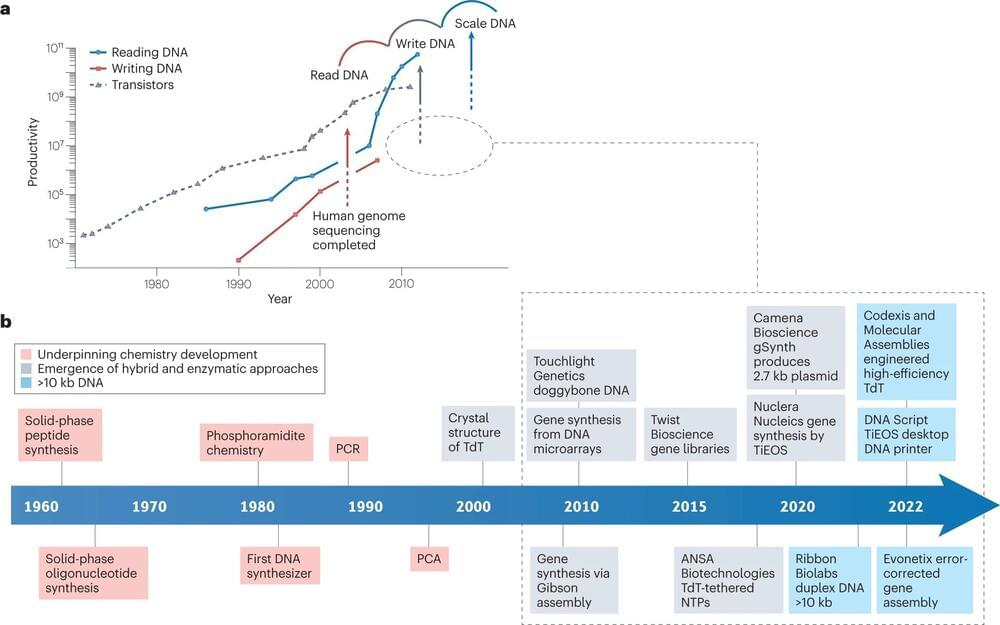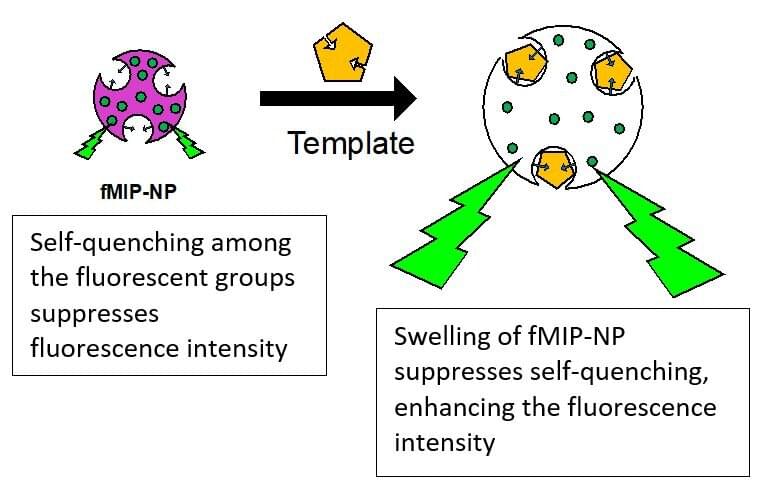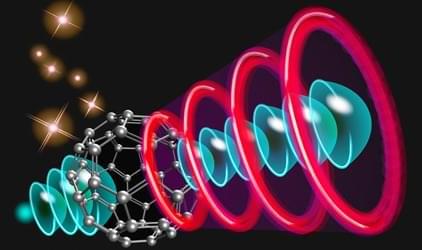Year 2022 This is their published work on the universal vaccine of the covid 19.
A mosaic sarbecovirus nanoparticle protects against SARS-2 and SARS-1, whereas a SARS-2 nanoparticle only protects against SARS-2.


Micron-sized “bow ties,” self-assembled from nanoparticles, form a variety of different curling shapes that can be precisely controlled, a research team led by the University of Michigan has shown.
The development opens the way for easily producing materials that interact with twisted light, providing new tools for machine vision and producing medicines.
While biology is full of twisted structures like DNA, known as chiral structures, the degree of twist is locked in—trying to change it breaks the structure. Now, researchers can engineer the degree of twist.
Researchers at Kanazawa University report in ACS Nano how high-speed atomic force microscopy can be used to study the biomolecular mechanisms underlying gene editing.
The DNA of prokaryotes—single-cell organisms, for example bacteria—is known to contain sequences that are derived from DNA fragments of viruses that infected the prokaryote earlier. These sequences, collectively referred to as CRISPR, for “clustered regularly interspaced short palindromic repeats,” play a major role in the antiviral defense system of bacteria, as they enable the recognition and subsequent neutralization of infecting viruses. The latter is done through the enzyme Cas9 (“CRISPR-associated protein 9”), a biomolecule that can locally unwind DNA, check for the existence of the CRISPR sequence and, when found, cut the DNA.
In recent years, CRISPR/Cas9 has emerged as a genome editing tool based on the notion that the Cas9 protein can be activated with artificially created CRISPR-like sequences. Sometimes, however, the wrong target is “caught” by Cas9—when the wrongly identified DNA sequence is too similar to the intended target sequence. It is therefore of crucial importance to fully understand how Cas9 binds to, “interrogates,” and cuts DNA. Mikihiro Shibata from Kanazawa University and colleagues have now succeeded in video-recording the DNA binding and cleaving dynamics of Staphylococcus aureus (a particular bacterium) Cas9 by means of high-speed atomic force microscopy (HS-AFM). Their observations will help to reach a more complete understanding of CRISPR-Cas9 mechanisms.

NPL, in collaboration with London Biofoundry and BiologIC Technologies Ltd, have released an analysis on existing and emerging DNA Synthesis technologies in Nature Reviews Chemistry, featuring the work on the front cover.
The study, which was initiated by DSTL, set out to understand the development trajectory of DNA Synthesis as a major industry drive for the UK economy over the next 10 years. The demand for synthetic DNA is growing exponentially. However, our ability to make, or write, DNA lags behind our ability to sequence, or read, it. The study reviewed existing and emerging DNA synthesis technologies developed to close this gene writing gap.
DNA or genes provide a universal tool to engineer and manipulate living systems. Recent progress in DNA synthesis has brought up limitless possibilities in a variety of industry sectors. Engineering biology, therapy and diagnostics, data storage, defense and nanotechnology are all set for unprecedented breakthroughs if DNA can be provided at scale and low cost.

The animal brain consists of tens of billions of neurons or nerve cells that perform complex tasks like processing emotions, learning, and making judgments by communicating with each other via neurotransmitters. These small signaling molecules diffuse—move from high to low concentration regions—between neurons, acting as chemical messengers.
Scientists believe that this diffusive motion might be at the heart of the brain’s superior function. Therefore, they have aimed to understand the role of specific neurotransmitters by detecting their release in the brain using amperometric and microdialysis methods. However, these methods provide insufficient information, necessitating better sensing techniques.
To this end, scientists developed an optical imaging method wherein protein probes change their fluorescence intensity upon detecting a specific neurotransmitter. Recently, a group of researchers from Shibaura Institute of Technology in Japan led by Professor Yasuo Yoshimi has taken this idea forward. They have successfully synthesized fluorescent molecularly imprinted polymeric nanoparticles (fMIP-NPs) that serve as probes to detect specific neurotransmitters–serotonin, dopamine, and acetylcholine.
Ray Kurzweil — The Singularity IS NEAR — part 2! We’ll Reach IMMORTALITY by 2030
Get ready for an exciting journey into the future with Ray Kurzweil’s The Singularity IS NEAR — Part 2! Join us as we explore the awe-inspiring possibilities of what could be achieved before 2030, including the potential for humans to reach immortality. We’ll dive into the incredible technology that could help us reach this singularity and uncover what the implications of achieving immortality could be. Don’t miss out on this fascinating insight into the future of mankind!
In his book “The Singularity Is Near”, futurist and inventor Ray Kurzweil argues that we are rapidly approaching a point in time known as the singularity. This refers to the moment when artificial intelligence and other technologies will become so advanced that they surpass human intelligence and change the course of human evolution forever.
Kurzweil predicts that by 2030, we will reach a crucial milestone in our technological progress: immortality. He bases this prediction on his observation of exponential growth in various fields such as genetics, nanotechnology, and robotics, which he believes will culminate in the creation of what he calls “nanobots”.
These tiny robots, according to Kurzweil, will be capable of repairing and enhancing our bodies at the cellular level, effectively making us immune to disease, aging, and death. Additionally, he believes that advances in brain-computer interfaces will allow us to upload our consciousness into digital form, effectively achieving immortality.
Kurzweil’s ideas have been met with both excitement and skepticism. Some people see the singularity as a moment of great potential, a time when we can overcome our biological limitations and create a better future for humanity. Others fear the singularity, believing that it could lead to the end of humanity as we know it.
Regardless of one’s opinion on the singularity, there is no denying that we are living in a time of rapid technological change. The future is uncertain, and it is impossible to predict with certainty what the world will look like in 2030 or beyond. However, one thing is clear: the singularity, as envisioned by Kurzweil and others, represents a profound shift in human history, one that will likely have far-reaching implications for generations to come.
0:00 Intro.
In the latest advance in nano-and micro-architected materials, engineers at Caltech have developed a new material made from numerous interconnected microscale knots.
The knots make the material far tougher than identically structured but unknotted materials: they absorb more energy and are able to deform more while still being able to return to their original shape undamaged. These new knotted materials may find applications in biomedicine as well as in aerospace applications due to their durability, possible biocompatibility, and extreme deformability.
“The capability to overcome the general trade-off between material deformability and tensile toughness [the ability to be stretched without breaking] offers new ways to design devices that are extremely flexible, durable, and can operate in extreme conditions,” says former Caltech graduate student Widianto P. Moestopo, now at Lawrence Livermore National Laboratory. Moestopo is the lead author of a paper on the nanoscale knots that was published on March 8 in Science Advances.

Alloys that can return to their original structure after being deformed have a so-called shape memory. This phenomenon and the resulting forces are used in many mechanical actuating systems, for example in generators or hydraulic pumps. However, it has not been possible to use this shape-memory effect at a small nanoscale. Objects made of shape-memory alloy can only change back to their original shape if they are larger than around 50 nanometers.
Researchers led by Salvador Pané, Professor of Materials of Robotics at ETH Zurich, and Xiang-Zhong Chen, a senior scientist in his group, were able to circumvent this limitation using ceramic materials. In a study published in the journal Nature Communications, they demonstrate the shape-memory effect on a layer that is about twenty nanometers thick and made of materials called ferroic oxides. This achievement now makes it possible to apply the shape-memory effect to tiny nanoscale machines.
At first glance, ferroic oxides do not appear to be very suitable for the shape-memory effect: They are brittle in bulk scale, and in order to produce very thin layers of them, they usually have to be fixed onto a substrate, which makes them inflexible. In order to still be able to induce the shape-memory effect, the researchers used two different oxides, barium titanate and cobalt ferrite, of which they temporarily applied thin layers onto a magnesium oxide substrate. The lattice parameters of the two oxides differ significantly from each other. After the researchers had detached the two-layered strip from the supporting substrate, the tension between the two oxides generated a spiral-shaped twisted structure.
How does the brain retrieve memories, articulate words, and focus attention? Recent advances have provided a newfound ability to decipher, sharpen, and adjust electrical signals relevant to speech, attention, memory and emotion. Join Brian Greene and leading neuroscientists György Buzsáki, Edward Chang, Michael Halassa, Michael Kahana and Helen Mayberg for a thrilling exploration of how we’re learning to read and manipulate the mind.
The Kavli Prize recognizes scientists for their seminal advances in astrophysics, nanoscience, and neuroscience — topics covered in the series “The Big, the Small, and the Complex.” This series is sponsored by The Kavli Foundation and The Norwegian Academy of Science and Letters.
Participants:
Michael Halassa.
Edward Chang.
Michael Kahana.
Helen S. Mayberg.
György Buzsáki.
Moderator:
Brian Greene.
SHARE YOUR THOUGHTS on this program through a short survey: https://survey.alchemer.com/s3/6752217/WSF-2022-Decoding-the-Brain.
WSF Landing Page Link: https://www.worldsciencefestival.com/programs/decoding-the-brain/

The ultimate miniature electronic device may be one that manipulates individual electrons with subnanometer and subfemtosecond precision. The past few decades have seen immense progress in the control of ultrafast electronic processes, including in the context of vacuum nanoelectronics, where electrons travel from a nanoscale emitter to a target electrode through a vacuum. Now Hirofumi Yanagisawa at the Japan Science and Technology Agency and colleagues have taken an important step toward optimal spatial control by using the orbitals of a single molecule to shape its electron emission (Fig. 1) [1]. The approach offers the prospect of building highly controllable electron emitters, but also of furthering our understanding of the role of molecular orbitals in the electronic structure of solids.
Fundamental to achieving extreme control over electron emission is defining the spot from which electrons are ejected from the emitter. One approach is to physically shape the material of the emitter into the desired spot pattern. Doing that at the subnanometer scale would entail significant material-and fabrication-related challenges, however. Instead, Yanagisawa and colleagues have demonstrated the clever idea of using the inherent electronic structure of a molecule to route the electrons for emission. In essence, the molecular orbitals are used as a spatial filter to control the emission pattern.
The team’s work grows out of two broad areas of investigation that have progressed significantly over the past few decades. One of these involves the study of femto-and attosecond electron dynamics and the creation of ultrafast electron sources, exemplified by the 2006 demonstration of tight spatial control over femtosecond electron pulses through emission from a nanoscale metallic tip [2– 8]. The second is the study of electron emission patterns originating from molecular structures and nanostructures. Examples include patterns corresponding to the tip structures of nanotubes and nanowires, which change as the tip evolves during nanotube growth [9– 11]. It is by combining the techniques of ultrafast emission and emission microscopy that Yanagisawa and colleagues have demonstrated that the emission patterns can be directly linked to specific molecular orbitals.